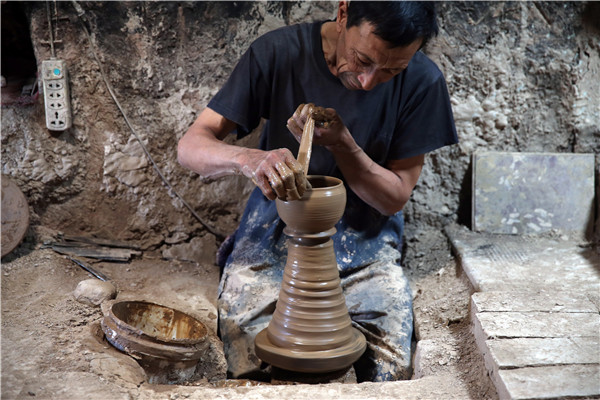Instrument makers dance to a traditional tune
 |
|
Tursunkhari Zunun makes a piece of traditional Uygur pottery.[Photo by ZOU HONG/CHINA DAILY]] |
Old customs need injection of new blood
Aniwar Ali's house sits on the edge of a 40-meter-high loess platform overlooking the Tuman River in Kashgar city, Xinjiang Uygur autonomous region.
The traditional Uygur residential area, known as the High Platform Neighborhood, has a history of more than 1,000 years, and is a landmark in Kashgar's old town.
The loess-loosely compacted yellowish-gray sediment-that produced the platform is also the raw material Aniwar, 50, and his brother Wumar, 45, use to make traditional Uygur bowls and jugs. The brothers are the sixth generation of a family of renowned potters.
At one time, traditional Uygur pottery items were daily essentials, but in recent decades cheaper porcelain has begun to dominate the market. "Nowadays, only old men use pottery tableware," Aniwar said.
Gradually, the traditional craft lost its appeal, and most of the potters in High Platform relinquished their careers. Now, only two families, including Aniwar's, still make a living by producing pottery.
"Our main customers are tourists, so we have begun making smaller products that are easier to pack in their luggage," said Aniwar, sitting in the courtyard of his house surrounded by a display of his wares. "Some tourists said they will use our oil lamps as ashtrays and the small spice jars to store coffee beans."
During the peak tourist season in the summer, the brothers make about 4,000 yuan ($590) a month.
Uygur pottery is known for its unique hand-painted patterns and the signature color combination of brown, black, green and cream. The loess material helps keep the contents warm while the exterior remains cool to the touch.
The brothers still use wood to fire their kiln because they believe coal-firing will affect the glaze of the pottery.
"I don't know how long my family can keep the tradition going-neither my sons nor my brother's boys want to learn the craft because it is hard, dirty work. They want to go to university and become doctors. We are very worried," Aniwar said.
As a result, he decided to take apprentices from outside the family, including four Han Chinese students. "I will teach anyone who wants to learn to keep Uygur traditions alive," he said.
Tursunkhari Zunun is Aniwar's neighbor. As a pottery maker, he has the same concerns. "My three daughters are all married now and my son is a policeman, so it is impossible for them to carry on the family tradition," he said.
The 62-year-old craftsman has advertised for apprentices in local newspapers, and although he provides a modest salary, none of his trainees have stayed for long.
He also teaches students at vocational schools, but they prefer to learn how to make nan bread, a popular local delicacy.
"My pottery is primitive. It is made without the use of any modern technology," he said, stepping on a pedal that powers a belt-driven wooden wheel in his centuries-old workshop.
While he fears modern technology will make traditional pottery lose its earthy beauty, he understands that the craft desperately needs new blood and fresh ideas. "I can use the old methods to produce pottery with modern designs and make this ancient craft popular again," he said.
Although Tursunkhari's children will not inherit his skills, he has two young apprentices from South Korea. They have had studied in his workshop for two years. "I have given them Uygur names and they are my disciples," he said.
Xinhua contributed to this story.

























